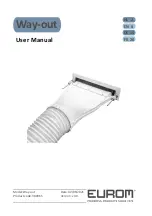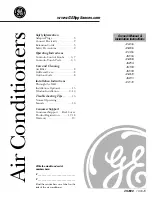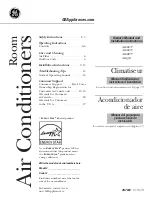
2
English
•
This equipment can be installed with a Ground-Fault Circuit
Interrupter (GFCI). Although this is a recognized measure
for additional protection, with the grounding system in North
America, a dedicated GFCI is not necessary.
•
When installing or relocating the system, keep the
refrigerant circuit free from substances other than the
specified refrigerant (R410A) such as air. Any presence of
air or other foreign substance in the refrigerant circuit can
cause an abnormal pressure rise or rupture, resulting in
injury.
•
Do not change the setting of the protection devices. If the
pressure switch, thermal switch, or other protection device
is shorted and operated forcibly, or parts other than those
specified by Daikin are used, fire or explosion may occur.
•
Do not install in a wet room such as a bathroom or laundry
room due to a risk of fire or electric shock.
CAUTION
•
Do not touch the switch with wet fingers. Touching a switch
with wet fingers can cause electric shock.
•
Do not allow children to play on or around the unit to
prevent injury.
•
Do not touch the refrigerant pipes during and immediately
after operation as the refrigerant pipes may be hot or
cold, depending on the condition of the refrigerant flowing
through the refrigerant piping, compressor, and other
refrigerant cycle parts. Your hands may suffer burns or
frostbite if you touch the refrigerant pipes. To avoid injury,
give the pipes time to return to normal temperature or, if
you must touch them, be sure to wear proper gloves.
•
Heat exchanger fins are sharp enough to cut.
To avoid injury wear gloves or cover the fins when working
around them.
•
Install drain piping to proper drainage. Improper drain
piping may result in water leakage and property damage.
•
Insulate piping to prevent condensation.
•
Be careful when transporting the unit.
•
Do not turn off the power supply immediately after
stopping operation. Always wait for at least 5 minutes
before turning off the power supply. Otherwise, water
leakage may occur.
•
Do not use a charging cylinder. Using a charging cylinder
may cause the refrigerant to deteriorate.
•
Refrigerant R410A in the system must be kept clean, dry,
and tight.
(a) Clean and Dry - Foreign materials (including mineral
oils such as SUNISO oil or moisture) should be pre-
vented from getting into the system.
(b) Tight - R410A does not contain any chlorine, does
not destroy the ozone layer, and does not reduce the
earth’s protection again harmful ultraviolet radiation.
R410A can contribute to the greenhouse effect if it is
released. Therefore take proper measures to check for
the tightness of the refrigerant piping installation. Read
the chapter Refrigerant Piping Work and follow the
procedures.
•
Since R410A is a blend, the required additional refrigerant
must be charged in its liquid state. If the refrigerant is
charged in a gaseous state, its composition can change
and the system will not work properly.
•
The indoor unit is for R410A. See the catalog for indoor
models that can be connected. Normal operation is not
possible when connected to other units.
•
Handheld remote controller (wireless kit) transmitting
distance can be shorter than expected in rooms with
electronic fluorescent lamps (inverter or rapid start types).
Install the indoor unit far away from fluorescent lamps as
much as possible.
•
Indoor units are for indoor installation only. Outdoor units
can be installed either outdoors or indoors.
•
Do not install the air conditioner or heat pump in the
following locations:
(a) Where a mineral oil mist or oil spray or vapor is pro-
duced, for example, in a kitchen.
Plastic parts may deteriorate and fall off or result in
water leakage.
(b) Where corrosive gas, such as sulfurous acid gas, is
produced.
Corroding copper pipes or soldered parts may result in
refrigerant leakage.
(c) Near machinery emitting electromagnetic waves.
Electromagnetic waves may disturb the operation of
the control system and cause the unit to malfunction.
(d) Where flammable gas may leak, where there is carbon
fiber, or ignitable dust suspension in the air, or where
volatile flammables such as thinner or gasoline are
handled. Operating the unit in such conditions can
cause fire.
NOTE
•
Install the power supply and transmission wires for the
indoor and outdoor units at least 3.5 ft. (1 m) away from
televisions or radios to prevent image interference or
noise. Depending on the radio waves, a distance of 3.5 ft.
(1 m) may not be sufficient to eliminate the noise.
•
Dismantling the unit, treatment of the refrigerant, oil and
additional parts must be done in accordance with the
relevant local, state, and national regulations.
•
Do not use the following tools that are used with
conventional refrigerants: gauge manifold, charge hose,
gas leak detector, reverse flow check valve, refrigerant
charge base, vacuum gauge, or refrigerant recovery
equipment.
•
If the conventional refrigerant and refrigerator oil are mixed
in R410A, the refrigerant may deteriorate.
•
This air conditioner or heat pump is an appliance that
should not be accessible to the general public.
•
As design pressure is 580 psi (4.0 MPa), the wall thickness
of field-installed pipes should be selected in accordance
with the relevant local, state, and national regulations.
01_EN_3P493125-6E.indd 2
2022/08/03 10:36:06




































